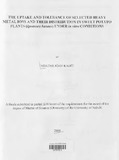| dc.contributor.author | Ndathe, J. K | |
| dc.contributor.author | Mwaura, F. B | |
| dc.contributor.author | Nsuba, J | |
| dc.contributor.author | Berga, L | |
| dc.contributor.author | Ndolo, P | |
| dc.contributor.author | Doty, S. L | |
| dc.contributor.author | Kamau, G.N | |
| dc.date.accessioned | 2013-06-19T15:04:56Z | |
| dc.date.available | 2013-06-19T15:04:56Z | |
| dc.date.issued | 2012 | |
| dc.identifier.citation | J. K. Ndathe, F. B. Mwaura, J. Nsuba, L. Berga, P. Ndolo, S. L. Doty and G.N. Kamau (2012). Rate of uptake of cadmium, chromium, lead and zinc ions by roots, stems and leaves of different ipomoea batatas plant varieties under in vitro conditions. International Journal of BioChemiPhysics, Vol. 20, pg 57-73December 2012 | en |
| dc.identifier.uri | http://erepository.uonbi.ac.ke:8080/xmlui/handle/123456789/36402 | |
| dc.description.abstract | Five sweet potato plant varieties grown in water solutions, containing varying amount of metal ions (Cd, Zn, Pb and Cr), demonstrated different rates of up take of the ions and distribution in leaves, roots and stems. Cadmium hydroponics exhibited high rates of metal intake into sweet potato plant varieties and could not tolerate concentrations exceeding 20 ppm of Cadmium. The five sweet potato plant varieties were Up-A, UP-B, UP-C, UP-D and UP-16. The rates of metal ion uptake increased with the increase in initial metal ion concentration of the hydroponics, but were independent of the amount of leaves, roots and stems. Overall, for the four metal ions and the five varieties considered, the lowest rates were recorded in leaves, whereas the highest rates were registered by roots or stems. For example, in case of 10 ppm Cd2+ ions solutions, the rates for the uptake by leaves, roots and stems increased as follows UP-B<UP-C<UP-16<UP-D<UP-A; UP-A<UP-D<UP-B<UP-16<UP-C; UP-C<UP-B<UP-D<UP-16<UP-A, respectively. Similar behavior was observed for other hydroponics containing different metal ions. This research work demonstrated ability of the sweet potato (SP) varieties to absorb and translocate heavy metal to roots, stems and leaves. The sp exhibited phyto-filtration (rhizofiltration) process, capable of cleaning up an environment contaminated with heavy metal pollutants. The rate of heavy metal uptake can be used to determine the plant varieties that are suitable to absorb high amounts of metal ions within a short time. | en |
| dc.language.iso | en | en |
| dc.title | Rate of uptake of cadmium, chromium, lead and zinc ions by roots, stems and leaves of different ipomoea batatas plant varieties under in vitro conditions | en |
| dc.type | Article | en |

